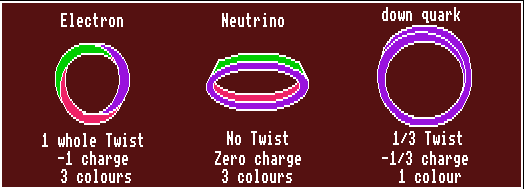

Quarks, on the other hand, are the constituent particles in hadrons, meaning heavy-weight particles, such as the neutron and proton. The quarks possess both an electrical charge, which is never integral always fractional, and a colour charge which is responsible for the strong nuclear force within atomic nuclei. Quarks can possess +1/3rd, -1/3rd, +2/3rd or -2/3rd electrical charge. The colour charge on a quark can take on any of three possibilities: red, green or blue (or their anti-colours, anti-red [=cyan], anti-green [=magenta] or anti-blue [=yellow]).
Neutrons and Protons both possess three quarks each. The three quarks within them always take on the three different colour charges, red, green and blue, such that from the outside the hardrons appear 'white'. (Red + green + blue make white in additive colour).
A neutron has two 'down' quarks with -1/3rd electrical charge and one 'up' quark with +2/3rd electrical charge. Thus the neutron is neutral overall.
A proton has two 'up' quarks with +2/3rd electrical charge and one 'down' quarks with -1/3rd electrical charge. The proton therefore has a net charge of +1.
In Beta decay, one of the 'down' quarks in a neutron changes into an 'up' quark, whilst at the same time emitting an electron and an anti-neutrino. Thus the neutron changes into a proton. Electrical charge is conserved; the electron carries off the unity negative charge, enabling a neutral neutron to change into a positively charged proton.
In Beta decay hadrons mysteriously change into leptons...

Thus a neutrino would consist of a ring without twists, and therefore no charge. It would have three sides, each able to carry a different colour charge - red, green and blue. It would therefore be colourless.
An electron would be a ring with one whole twist in it, forming an electrical charge of one whole unit. Still with three sides, it too would be colourless.
A down quark would be a ring with a single -1/3rd twist, and therefore possess an electrical charge of -1/3. But with only one side it can have only one colour: red or green or blue.
An up quark, with two 1/3rd twists, but in the opposite direction, would have an electrical charge of +2/3. Having just one side, it has but one colour: red or green or blue.
Twists in opposite directions, being mirror images, would give anti-particles (with the sides possessing anti-colours - anti-red, anti-green and anti-blue)
Note that a neutrino, having no twists, would have no anti-particle.
A quark and anti-quark ring could be linked together to form a non-coloured meson. Three such quark rings entwined together in either a Borromean or a non-Borromean ring arrangement could form a colourless baryon, e.g. a proton.
This theory successfully explains why sub-atomic particles with fractional electrical charge must be coloured and experience the colour force, and why those with integral electrical charge must be colourless (white) and cannot experience the colour force.
Just as a matter of additional interest, if a twisted tri-prism ring with 1/3rd of a twist is cut lengthwise all along along the edge, then a single loop results of three times the length, and with 3/2 twists.
Similarly, if a twisted tri-prism ring with 3/3rds (one whole twist) of a twist is cut lengthwise along the edges, then three separate but interlocking rings result. Each ring has one whole twist. The three interlocked rings are non-Borromean, that is, if one ring is cut, the other two are still linked.
Mesons will also fit into this scheme: they consist of two quarks, a quark and anti-quark pair. Being particle-anti-particle pairs both their fractional electrical charges and their colour charges cancel. They too can be a linked-ring pair, a meson. See Borromean Nuclei.
Gluons will also fit into this scheme. Gluons are gauge particles, they carry the colour force, and have 2 colours each, but are electrically neutral. They thus have a colour charge (they cannot be white with only 2 colours). Without electrical charge they must have zero twists. Thus they are annular rings, with two sides, which are coloured on each side; two colours, but not three. If you have two primary colours together, the result is one anti-colour (for example, if one side was green, the other red, the resulting colour is yellow - an anti-colour. Or if you have a primary colour one side, say red, and an anti-colour on the other side, say anti-blue [which is yellow], the resulting colour is a peculiar admixture).
If the three quarks of a proton (or neutron) are inter-linked around each other like a Borromean ring, then it is obvious why they cannot be parted. Or perhaps the three quarks adopt a single continuous tortuous path similar to a trefoil knot arrangement. It is obvious that if you start pulling one loop of the trefoil knot then the others get smaller resisting: they cannot be separated. And even if you succeeded in separating them, then they would no longer be quarks, but something else.
Note that a Borromean Ring (or a Trefoil knot) has three 'crossings'. What if two 2-colour gluon annular ring encircled each of the three crossings. This would be a neat solution. However, never let your imagination think that quarks really are twisted three-sided rings and gluons non-twisted annular rings, this is just a convenient way of visualising it. The quarks and gluons are inextricably linked with each other, continually exchanging colours between both their like selves and between the quarks and gluons. So much so that it is impossible to pin down the colour of any one quark or gluon. It is not even possible to pin down their spatial configuration, the two are inextricably linked to each other in more ways imaginable; its all just a fuzz. Think wave-particle duality, they are not quarks, they are not gluons, they are inextricably melded to each other.
But my twisted tri-prisms and flat annular rings enable the normal person to see that this is how it could be visualised, but in a higher un-imaginable plane where more dimensions exist than just the three we can visualise.
Roger Whitney Darlington, January 1996
This theory successfully explains why sub-atomic particles with fractional charge must experience the colour force, and why those with integral charge are colourless (white) and do not experience the colour force. In particular, it shows how leptons (electrons, positrons and neutrinos) and hadrons (neutrons and protons containing quarks) are actually related to each other.
![]()
![]()